Page 271 of 474
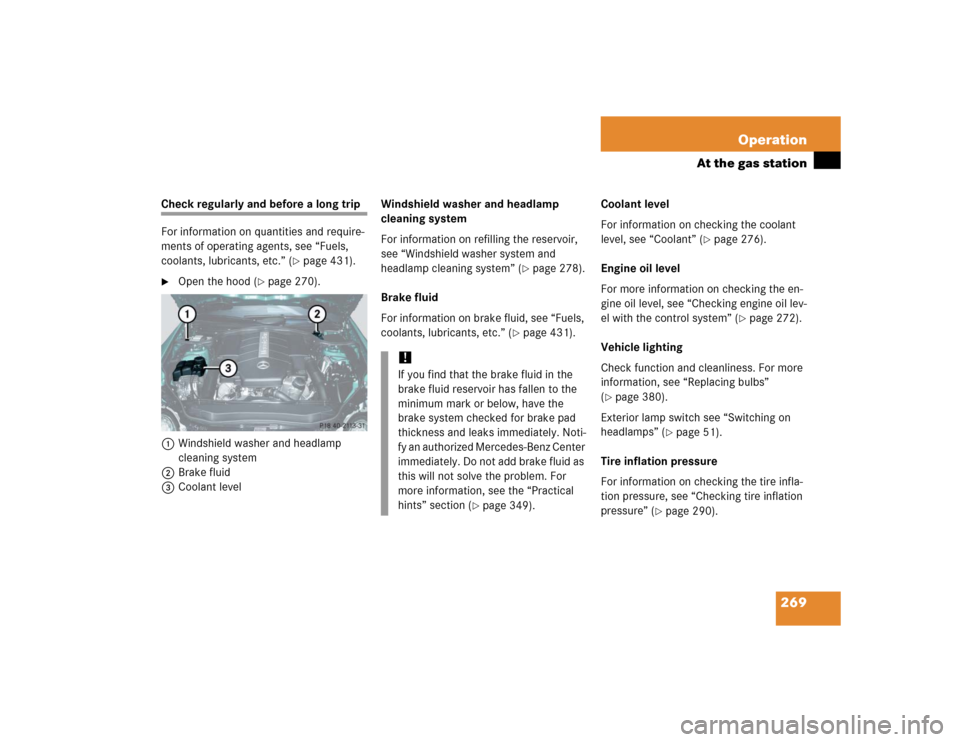
269 Operation
At the gas station
Check regularly and before a long trip
For information on quantities and require-
ments of operating agents, see “Fuels,
coolants, lubricants, etc.” (
�page 431).
�
Open the hood (
�page 270).
1Windshield washer and headlamp
cleaning system
2Brake fluid
3Coolant levelWindshield washer and headlamp
cleaning system
For information on refilling the reservoir,
see “Windshield washer system and
headlamp cleaning system” (
�page 278).
Brake fluid
For information on brake fluid, see “Fuels,
coolants, lubricants, etc.” (
�page 431).Coolant level
For information on checking the coolant
level, see “Coolant” (
�page 276).
Engine oil level
For more information on checking the en-
gine oil level, see “Checking engine oil lev-
el with the control system” (
�page 272).
Vehicle lighting
Check function and cleanliness. For more
information, see “Replacing bulbs”
(
�page 380).
Exterior lamp switch see “Switching on
headlamps” (
�page 51).
Tire inflation pressure
For information on checking the tire infla-
tion pressure, see “Checking tire inflation
pressure” (
�page 290).
!If you find that the brake fluid in the
brake fluid reservoir has fallen to the
minimum mark or below, have the
brake system checked for brake pad
thickness and leaks immediately. Noti-
fy an authorized Mercedes-Benz Center
immediately. Do not add brake fluid as
this will not solve the problem. For
more information, see the “Practical
hints” section (
�page 349).
Page 273 of 474
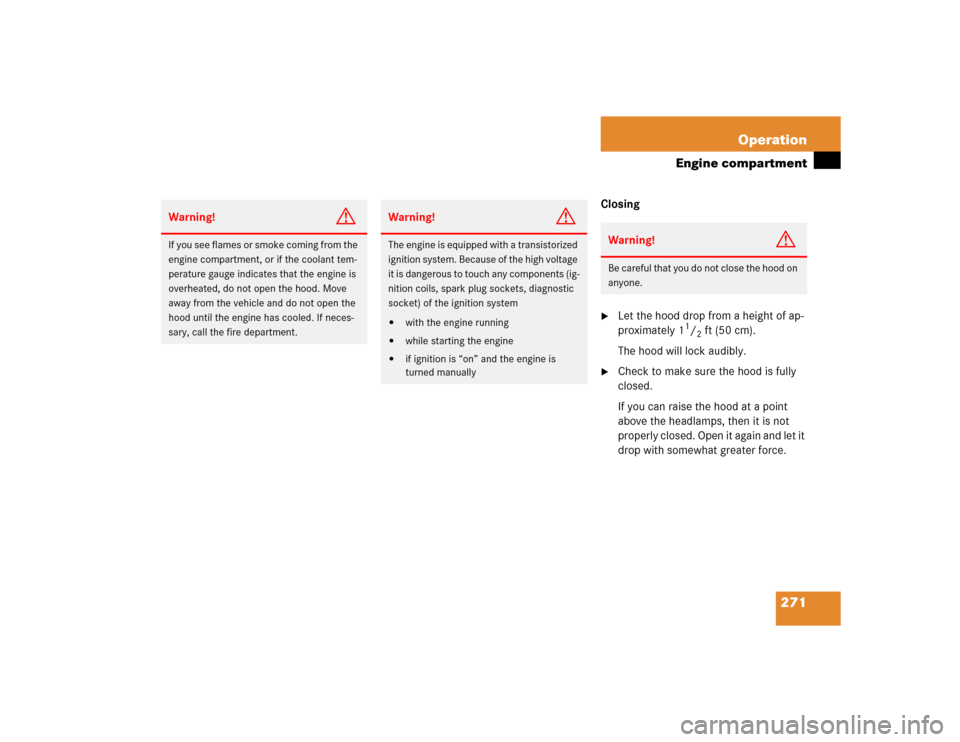
271 Operation
Engine compartment
Closing�
Let the hood drop from a height of ap-
proximately 1
1/2ft (50 cm).
The hood will lock audibly.
�
Check to make sure the hood is fully
closed.
If you can raise the hood at a point
above the headlamps, then it is not
properly closed. Open it again and let it
drop with somewhat greater force.
Warning!
G
If you see flames or smoke coming from the
engine compartment, or if the coolant tem-
perature gauge indicates that the engine is
overheated, do not open the hood. Move
away from the vehicle and do not open the
hood until the engine has cooled. If neces-
sary, call the fire department.
Warning!
G
The engine is equipped with a transistorized
ignition system. Because of the high voltage
it is dangerous to touch any components (ig-
nition coils, spark plug sockets, diagnostic
socket) of the ignition system�
with the engine running
�
while starting the engine
�
if ignition is “on” and the engine is
turned manually
Warning!
G
Be careful that you do not close the hood on
anyone.
Page 278 of 474
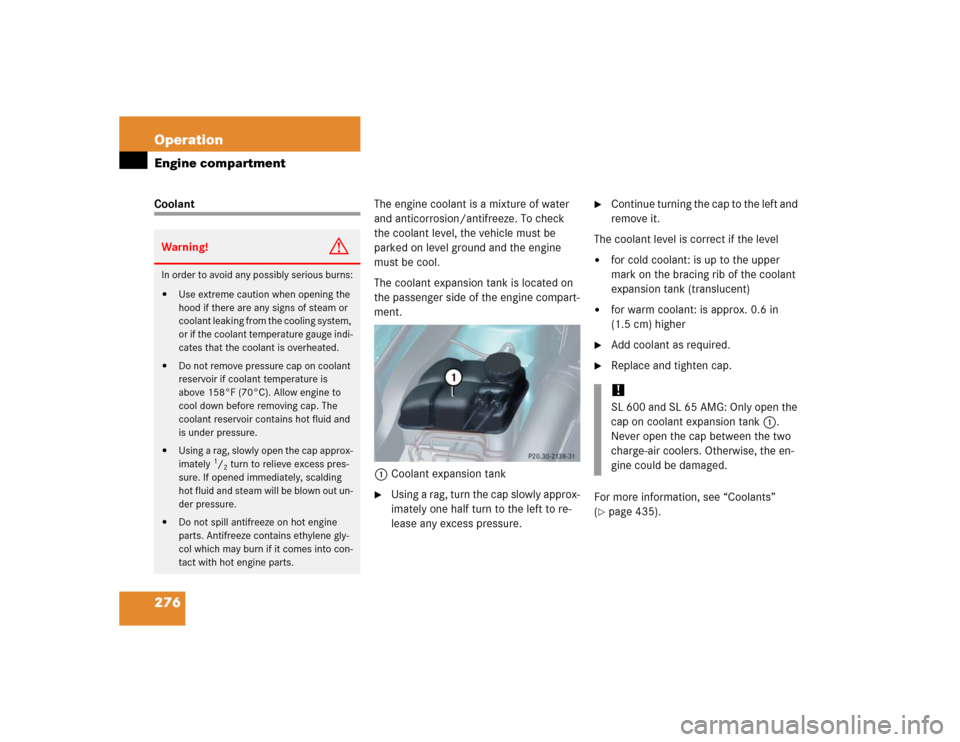
276 OperationEngine compartmentCoolantThe engine coolant is a mixture of water
and anticorrosion/antifreeze. To check
the coolant level, the vehicle must be
parked on level ground and the engine
must be cool.
The coolant expansion tank is located on
the passenger side of the engine compart-
ment.
1Coolant expansion tank
�
Using a rag, turn the cap slowly approx-
imately one half turn to the left to re-
lease any excess pressure.
�
Continue turning the cap to the left and
remove it.
The coolant level is correct if the level
�
for cold coolant: is up to the upper
mark on the bracing rib of the coolant
expansion tank (translucent)
�
for warm coolant: is approx. 0.6 in
(1.5 cm) higher
�
Add coolant as required.
�
Replace and tighten cap.
For more information, see “Coolants”
(
�page 435).
Warning!
G
In order to avoid any possibly serious burns:�
Use extreme caution when opening the
hood if there are any signs of steam or
coolant leaking from the cooling system,
or if the coolant temperature gauge indi-
cates that the coolant is overheated.
�
Do not remove pressure cap on coolant
reservoir if coolant temperature is
above 158°F (70°C). Allow engine to
cool down before removing cap. The
coolant reservoir contains hot fluid and
is under pressure.
�
Using a rag, slowly open the cap approx-
imately
1/2 turn to relieve excess pres-
sure. If opened immediately, scalding
hot fluid and steam will be blown out un-
der pressure.
�
Do not spill antifreeze on hot engine
parts. Antifreeze contains ethylene gly-
col which may burn if it comes into con-
tact with hot engine parts.
!SL 600 and SL 65 AMG: Only open the
cap on coolant expansion tank1.
Never open the cap between the two
charge-air coolers. Otherwise, the en-
gine could be damaged.
Page 330 of 474

328 Practical hintsWhat to do if …Problem
Possible cause
Suggested solution
ú
(USA only)
±
(Canada only)
The yellow engine malfunction
indicator lamp comes on while
driving.
Your fuel tank is empty.
�
After refuelling, start, turn off, and re-
start the engine three or four times in
succession.
The limp-home mode is canceled. You
do not need to have your vehicle
checked.
D
The red coolant warning lamp
comes on when the engine is
running.
There is insufficient coolant in the reservoir.
If this warning lamp comes on frequently,
there is a leak in the cooling system.
If the coolant level is correct, the electric ra-
diator fan may be broken.
�
Immediately add coolant to prevent
engine from overheating
(�page 276).
�
Have the cooling system checked.
�
If the coolant temperature is below
248 °F (120 °C), you can continue
driving to the nearest authorized
Mercedes-Benz Center.
�
Avoid high engine loads (e.g. driving
uphill) and stop-and-go driving.
D
The red coolant warning lamp
comes on while driving and you
hear a warning sound.
The coolant temperature has exceeded
248 °F (120 °C).
�
Stop as soon as possible and allow
the engine and coolant to cool down.
Page 353 of 474
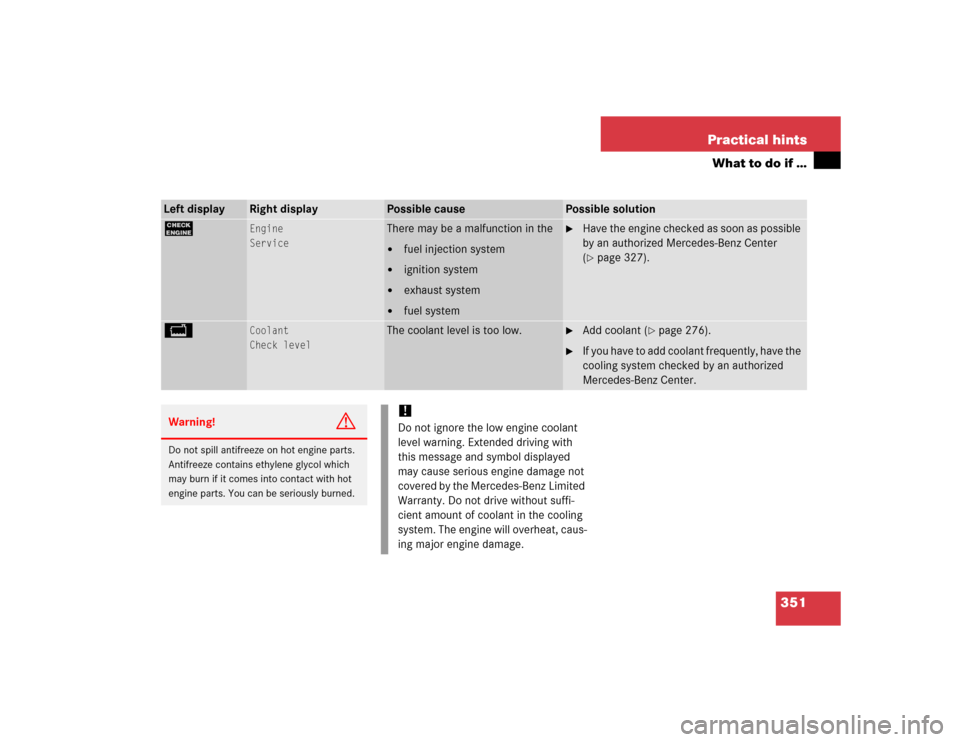
351 Practical hints
What to do if …
Left display
Right display
Possible cause
Possible solution
?
Engine
Service
There may be a malfunction in the �
fuel injection system
�
ignition system
�
exhaust system
�
fuel system
�
Have the engine checked as soon as possible
by an authorized Mercedes-Benz Center
(�page 327).
B
Coolant
Check level
The coolant level is too low.
�
Add coolant (
�page 276).
�
If you have to add coolant frequently, have the
cooling system checked by an authorized
Mercedes-Benz Center.
Warning!
G
Do not spill antifreeze on hot engine parts.
Antifreeze contains ethylene glycol which
may burn if it comes into contact with hot
engine parts. You can be seriously burned.
!Do not ignore the low engine coolant
level warning. Extended driving with
this message and symbol displayed
may cause serious engine damage not
covered by the Mercedes-Benz Limited
Warranty. Do not drive without suffi-
cient amount of coolant in the cooling
system. The engine will overheat, caus-
ing major engine damage.
Page 354 of 474
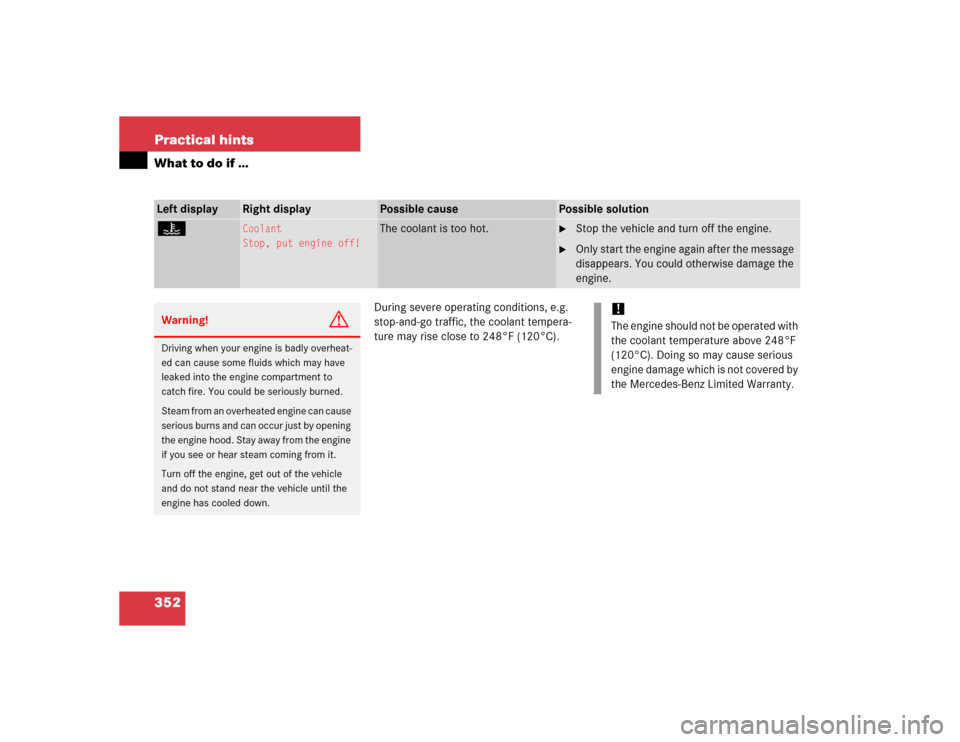
352 Practical hintsWhat to do if …
During severe operating conditions, e.g.
stop-and-go traffic, the coolant tempera-
ture may rise close to 248°F (120°C).
Left display
Right display
Possible cause
Possible solution
•
Coolant
Stop, put engine off!
The coolant is too hot.
�
Stop the vehicle and turn off the engine.
�
Only start the engine again after the message
disappears. You could otherwise damage the
engine.
Warning!
G
Driving when your engine is badly overheat-
ed can cause some fluids which may have
leaked into the engine compartment to
catch fire. You could be seriously burned.
Steam from an overheated engine can cause
serious burns and can occur just by opening
the engine hood. Stay away from the engine
if you see or hear steam coming from it.
Turn off the engine, get out of the vehicle
and do not stand near the vehicle until the
engine has cooled down.
!The engine should not be operated with
the coolant temperature above 248°F
(120°C). Doing so may cause serious
engine damage which is not covered by
the Mercedes-Benz Limited Warranty.
Page 355 of 474
353 Practical hints
What to do if …
Left display
Right display
Possible cause
Possible solution
•
Coolant
Stop, put engine off!
The poly-V-belt could be broken.
�
Stop immediately and check the poly-V-belt.
If it is broken:
�
Do not continue to drive. Otherwise, the en-
gine will overheat due to an inoperative water
pump which may result in damage to the en-
gine. Notify an authorized Mercedes-Benz
Center.
If it is intact:
�
Do not continue to drive with this message
displayed. Doing so could result in serious en-
gine damage that is not covered by the
Mercedes-Benz Limited Warranty.
•
Coolant
Visit
workshop
The cooling fan for the coolant is
malfunctioning.
�
Observe the coolant temperature gauge.
�
Have the fan replaced as soon as possible.
Page 417 of 474
415 Technical data
Parts service
Warranty coverage
Identification labels
Layout of poly-V-belt drive
Engine
Rims and tires
Electrical system
Main dimensions
Weights
Fuels, coolants, lubricants, etc.